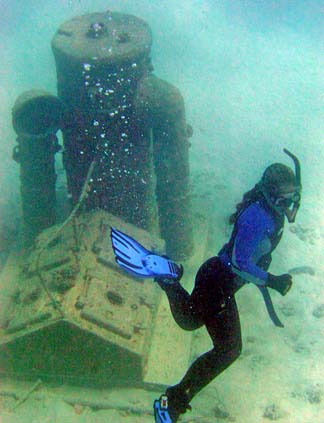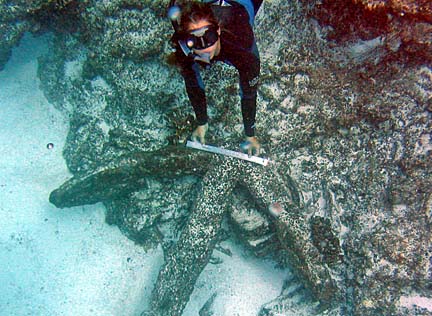— ADVERTISEMENT —


|
Reef cleanup reveals
wreck clues
Divers removing nets from
a Hawaiian atoll find what
might be ships sunk circa 1822
Back in the early 1800s, whaling ships hunted whales for their oil, which was used in lamps.
Earlier this month, as divers were removing marine debris from the Northwestern Hawaiian Islands with the aim of protecting the ocean's mammals -- including whales -- they found what are believed to the remains of British whaling ships.
The Pearl and the Hermes ran aground in 1822 on the atoll that now bears their names.

|
Hans Van Tilburg, Pacific marine heritage coordinator for the National Marine Sanctuary Program, said he finds a "larger irony" in that the 123 tons of net and rope gathered this year will be converted to electricity at Honolulu's HPOWER waste-to-energy plant.
"The debris will be burned to light cities and towns, just like we used to do with the whale oil," he said yesterday at a press conference on the unexpected double success of the recently completed mission of divers for the National Oceanic and Atmospheric Administration.
"I can't say that we've got positive identification," Van Tilburg said, "but this site could very well be the Pearl and Hermes."
Although the wreck of two whalers was "a tragic moment in maritime history ... sites like this are windows into our past," Van Tilburg said.
Items at the wreck site include anchors, trypots (cauldrons) used to process whale oil, copper hardware and even small cannons and cannonballs, all scattered over hundreds of yards in relatively shallow water.
Van Tilburg and other marine history experts will examine the site more closely during another trip scheduled for May.
Between now and then, he will be researching boats' histories and studying the underwater photos and measurements of the wreck site brought back by divers on the Casitas, a contract vessel that returned from the Northwestern Hawaiian Islands on Monday.
Pearl and Hermes Atoll reef has been a "mother lode" of nets, rope, floats and other marine debris washed there by ocean currents, said Jake Asher, a NOAA team leader for the Casitas voyages from June to October.
After four years of intensive debris cleanups in the Northwestern Hawaiian Islands, "we're seeing a difference in what we're doing. We're seeing progress in the amount of nets out there," Asher said.
"I think this year we're over the big hurdle" in the goal of getting the nearly pristine islands cleared of flotsam and jetsam, said Rusty Brainard, program director of coral reef ecology for NOAA's Pacific Islands Fisheries Science Center.
Past cleanups hauled in 69 tons in 2001, then 108 tons in 2002 and 122 tons last year, Brainard said.
The effort to clear marine debris from the uninhabited Northwestern Hawaiian Islands was kicked off after biologists studying the endangered Hawaiian monk seal found two pups tangled and drowned in drifting nets. The debris comes from all over the Pacific and is an international problem, Brainard said.
— ADVERTISEMENTS —
— ADVERTISEMENTS —